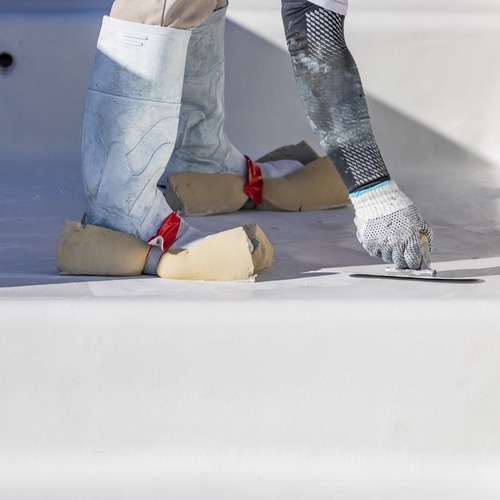
What is the Life Expectancy of a Single Ply Roof?
Tornados and other intense weather conditions are common in this area. This leaves commercial and industrial structures subjected to hard rains, hailstones, and high winds, which damage their rooftops. These are common reasons structures often need single-ply roof repair in Grain Valley, Missouri, or even complete roof replacement. So, how long can you generally expect a single-ply roof to last, even when subjected to poor weather conditions?
What is single-ply roofing?
Most commercial and industrial structures have low-sloping roofs, and single-ply roofing is the type of roofing material best suited for these roofs. A single-ply roofing material comes in rolls of wide widths rolled out on the job site. The wide widths leave fewer seams, which leaves fewer chances for leaking roofs and less need for single-ply roof repairs.
Can you stand or walk on a single-ply roof?
Because most commercial and industrial structures have their HVAC equipment installed on the roof, choosing a roofing material that can withstand foot traffic is essential. A single-ply roof material installed correctly and maintained well can hold up to occasional, light foot traffic.
Have the roofing contractor install a walkway to and around the HVAC equipment to help ease the pressure of that foot traffic. Advise the HVAC technician of the roofing material type and advise them to wear proper footwear to minimize slipping if the rooftop is wet.
What is the most common problem associated with a single-ply membrane roof?
While a single-ply roof is a waterproof, durable, and flexible membrane, it does have some downsides:
- Failed Seams: Over time, a single-ply roof membrane will become brittle, lose its elasticity, and shrink, putting the membrane under stress and causing the seams to fail in their waterproofing duties. If a roofer doesn’t install a single-ply roof correctly, seam failure can occur, so it’s vital to use a commercial roofing contractor with experience in single-ply roof installation, repair, and maintenance services.
- Failed Attachment: The weather can damage any kind of roofing, including single-ply roofs. You may require repairs because of hailstones, hard rains, and high winds. The wind can lift the membrane of a single-ply roof where the attachment is weak, making the roof vulnerable to rain. When the affected area isn’t too large, a roofing contractor can perform a single-ply roof repair with metal plates and screws to reattach the membrane to the decking.
- Blistering: A single-ply roof repair is often needed for blistering caused by a loss of adhesion between the roof membrane and the underlying roofing material. This blistering happens when moisture becomes trapped under the roof surface. The larger the blisters, the more moisture is collected, leaving the roof vulnerable to leaks. Routine inspections are important to find small blisters and have single-ply roof repairs done sooner rather than later.
What can happen if you delay single-ply roof repairs?
When you schedule a monthly roof inspection, you can identify problems such as blistering, punctures, tears, or seams breaking loose. Ensure you get any necessary single-ply roof repairs when you identify these kinds of issues, and call a professional commercial roofing contractor for the help you need. Also, remember that it takes the right material for single-ply roof repairs to ensure a long-lasting repair and to prevent further deterioration. When you delay seeking professional single-ply roof repairs, damage can occur from moisture intrusion.
Who do you call, and how are single-ply roof repairs done?
If the warranty on the single-ply roofing system is still current, call the installation contractor for the single-ply roof repair job. If the warranty has expired and you didn’t take the service contract, find a commercial roofing contractor who is experienced in single-ply roofing and is certified and licensed by the roofing material manufacturer.
The following is a step-by-step single-ply roof repair process. The method a contractor deems best may vary.
Step One: The contractor will do a visual inspection to locate and identify the issue needing single-ply roof repair.
Step Two: The roofing contractor’s crew will set up their safety equipment and unload the equipment and materials needed for a single-ply roof repair.
Step Three: The crew will then prep the area of the single-ply roof repair by cleaning it, making any minor repairs to the structure under the roofing membrane if needed, and preparing the area to be patched.
Step Four: Next, the crew will apply the single-ply roof repair patch using the material and process based on the type of existing roofing membrane. For a PVC or TPO roof, the crew will heat-weld a new membrane patch. The contractor may apply a primer and peel-and-stick tape for some EPDM or thermoset single-ply roof repairs.
In Closing
Reading this blog about single-ply roof repairs may make you wonder if a single-ply roof is the correct type of roofing material for your needs. What is the life expectancy of a single-ply roof? It is a durable and flexible material that can serve your commercial or industrial building for up to 40 years. Manufacturers make and test single-ply materials to meet industry standards and to earn BBA certification. When you get this kind of roof, remember to get a regular inspection from a professional commercial roofing contractor and keep up with your repairs. By doing so, you can ensure that it will last for decades.